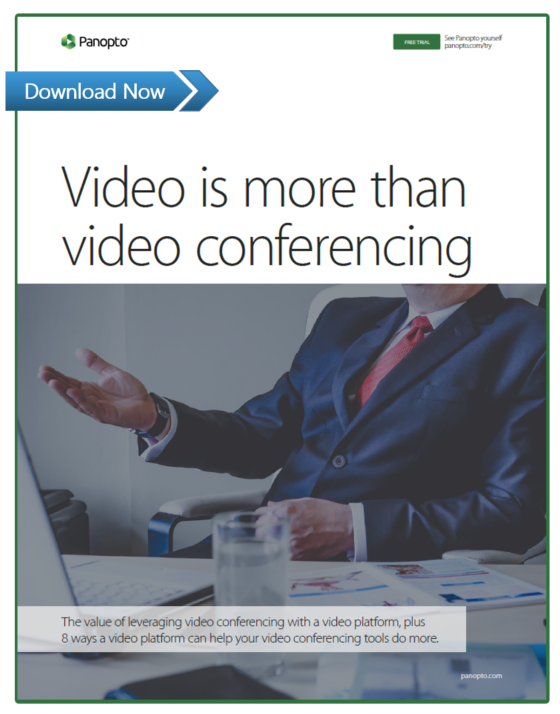- Communications
10 Signs You Should Be Investing In On-Demand Video For Your Business

Short of face-to-face conversations, video is the single most powerful way to share information.
Which is why many businesses have put a toe into the shallow end of video – setting up video conferencing systems to enable more real-time conversations with far more efficiency.
Companies that stop at real-time video conferencing, however, are missing out.
On-demand, asynchronous video can similarly enhance collaboration, communication, training, and overall productivity within your organization in ways that live video communication simply can not. And with the right tool, it’s as easy as pressing “record.”
So how can you tell if it’s time for your organization to better support on-demand video?
Here Are 10 Signs It’s Time To Go Beyond Video Conferencing
- You’re growing, and need to onboard quickly. A video-based welcome and onboarding series is a proven means to help new employees learn your culture while freeing your HR and training teams to tackle other challenges.
- You’ve got a ton of experienced people, and want to capture that institutional knowledge. Don’t let your strategic advantage hand in its two-week notice. Record your subject matter experts demonstrating how products, systems, and processes work, and make it available for anyone in your organization to search and view on-demand.
- You’re investing in events – that your people can’t always attend. Whether they’re training activities, executive presentations, thought leadership discussions, or anything else, if your event is valuable enough for your people to attend, it is valuable enough for you to record and make available on-demand for everyone.
- Your people keep asking for more executive communication. A common request at most organizations is transparency. Your people want to know what’s going on. And while regular emails, blog posts, and other activities help, there’s nothing more powerful (or easier to create!) than a 5-minute video of your CEO detailing next year’s plans.
- Your people are already creating videos and don’t know what to do with the files. Too many organizations fail to consider where to keep the video they’ve already started creating. The result is an unpleasant choice: tax the storage limits of your SharePoint solutions, or post internal videos to sites like YouTube. A better option is a video content management system (a video CMS) – which would provide scalability, security, and central access all in one easy place.
- Your teams don’t seem to know each other’s best practices. Especially for larger organizations set up in small stand-alone (ok, siloed) teams, it can be hard to know what other teams already know. Video makes “social learning” easy by making it simple both to record a best practice demonstration and to view it. A good video system even makes it easy to search video, so your people can find what they need even if they don’t know it already exists.
- Your people are spread across multiple buildings. One of the best ways to work within and across teams is simply to walk over for a quick chat. That’s more difficult when building walls must be crossed. Video presents a new opportunity: the “virtual” walkover. Your people can record their comments or ideas – even share a computer screen as well – and better get their messages across and keep work moving.
- Your people are spread across multiple continents. It is incredibly easy for teams separated by an ocean to begin operating independently – especially when communication is limited to email. Video helps connect international teams, giving everyone access to local events, giving a better view of local situations needs, and just putting faces to names.
- Your network bandwidth is already getting taxed. While video is a superior communications tool to the simple written word, it’s also quite a bit harder on your network – especially if it isn’t centrally managed. Too many organizations allow individual teams to find their own video solutions – an unscalable decision that creates internal competition for network bandwidth and slows everyone down.
- Your video conferencing doesn’t scale. Video conferencing is great for small conversations in real time. But what if you want to share that conference with a large group? Most video conferencing vendors limit available seats at 250 or 1000. A video content management system includes live streaming software to help you stream those conferences to thousands – even tens of thousands – more people.
Recognize any of these signs in your own organization?
A video platform that integrates with your video conferencing software and other business system might be just what you need. It’s like a private YouTube for all your organizations video recordings. With it, your employees can easily capture, store, search and share on-demand video content to improve the flow of critical information throughout your business.
Put On-Demand Video To Work For Your Business
 Find out how a video platform can help maximize your investment in video and get practical recommendations for enterprise video from the industry leaders like Gartner, Forrester, Siemens, and more in our latest white paper.
Find out how a video platform can help maximize your investment in video and get practical recommendations for enterprise video from the industry leaders like Gartner, Forrester, Siemens, and more in our latest white paper.




